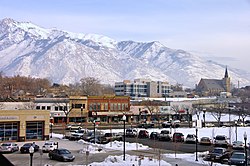Wasatch Front
This article needs additional citations for verification. (April 2022) |
Wasatch Front | |
|---|---|
 | |
 | |
 Downtown Ogden | |
| Country | United States |
| State | Utah |
| Population (2020) | 2,660,359 |
The Wasatch Front
Geography
The Wasatch Front is a long and relatively narrow strip of land, measuring about 177 kilometers (110 miles) north to south and 48 kilometers (30 miles) east to west at the widest points. To the east, the Wasatch Mountains rise abruptly several thousand feet above the valley floors, climbing to their highest elevation of 11,928 feet (3,636 m) at Mount Nebo (bordering southern Utah Valley). The area's western boundary is formed by Utah Lake in Utah County, the Oquirrh Mountains in Salt Lake County, and the Great Salt Lake in northwestern Salt Lake, Davis, Weber, and southeastern Box Elder county.
Though most residents of the area live between Ogden and Provo (a distance of 80 miles [130 km]), which includes Salt Lake City proper, the fullest built-out extent of the Wasatch Front is 120 miles (190 km) long and on average 5 miles (8 km) wide. Along its length, the Wasatch Front never exceeds a width of approximately 18 miles (29 km) because of the natural barriers of lakes and mountains.[citation needed]
Sustained drought in Utah has more recently strained the region's water security, causing the Great Salt Lake to drop to record low levels,[2][3] and affecting the state's economy, of which the Wasatch Front constitutes 80%.[4]
Climate
The Wasatch Front is a
Summers are generally hot and dry, with the exception of the summer thunderstorm seasonal pattern which usually runs from early July through early September, when often intense thunderstorms occur due to mid-latitude weather patterns including the Pacific storm track.[6] Daytime high temperatures are around 95 °F (35 °C), with higher temperatures often created by the urban heat island effect.[7]
Population centers

Several
| Rank | County | 2010 census[8] | 2020 census[9] | Growth % |
|---|---|---|---|---|
| 1 | Salt Lake | 1,029,655 | 1,185,238 | +15.11% |
| 2 | Utah | 516,564 | 659,399 | +27.65% |
| 3 | Davis | 306,479 | 362,679 | +18.34% |
| 4 | Weber | 231,236 | 262,223 | +13.40% |
| 8 | Box Elder | 49,975 | 57,666 | +15.39% |
| Total | 2,246,565 | 2,660,359 | +18.42% | |
Transportation

Ogden has served as a major railway hub through much of its history. The First transcontinental railroad was constructed between 1863 and 1869, with the tracks reaching Ogden on March 27, 1869. Trains heading east from Ogden must negotiate the highest reaches of eastern Utah, travelling through Weber and Echo Canyons and over the Wasatch Pass at an elevation of 6,792 feet.
Transportation issues within the metropolitan area have been complicated by the narrow north–south orientation of the valley, constrained by the natural barriers on both sides, and the rapid growth of the region.
The primary modes of transport for the area are
The Utah Transit Authority provides bus and light rail (TRAX) service to most of the urban areas within the Wasatch Front. Additionally, a double-decker commuter rail line FrontRunner,[11] running from North Ogden to Provo, is in full operation.[12]
The California Zephyr of Amtrak[13] is the primary rail transport leading in and out of the Wasatch Front, having a station in Salt Lake City and Provo.
Growth and land use
Because of the geographical barriers to the east and west, much of the land along the Wasatch Front has been developed. The region has experienced considerable growth since the 1950s, with its population increasing 308% from 492,374 to 2,051,330. Much of the remaining undeveloped land is rapidly being developed, and local governments have grappled with problems of urban sprawl and other land-use concerns.
The region on the other side of the Wasatch Range, including cities such as Park City, Morgan, Heber City, and Midway, is sometimes referred to as the Wasatch Back and has recently shared in the rapid growth of the region.

See also
- Salt Lake City metropolitan area
- Wasatch Back
- Wasatch Fault
- 2003 Utah snowstorm
- Payson-Dixon line
References
- ^ a b "Megalopolis: Urban sprawl slowly blurs Wasatch Front towns, cities". Deseret News. 2008-05-18. Retrieved 2022-04-30.
- ^ "Drought 2022". www.slc.gov. Retrieved April 16, 2022.[title missing]
- ^ "Great Salt Lake Reaches New Historic Low". USGS. U.S. Department of the Interior. Retrieved April 16, 2022.
- ^ "If we want growth, we need water solutions". www.utahbusiness.com. 11 May 2022. Retrieved July 13, 2022.[title missing]
- ^ "Utah Planting Zones". Gilmour.
- ISSN 0027-0644.
- ^ "Utah Weather". Visit Utah.
- ^ "TOTAL POPULATION (P1)". United States Census Bureau. 2010. Retrieved April 30, 2022.
- ^ "TOTAL POPULATION (B01003)". United States Census Bureau. 2020. Retrieved April 30, 2022.
- ^ "Utah - Map of Cities in UT - MapQuest". www.mapquest.com.
- ^ "404". www.rideuta.com.
{{cite web}}: Cite uses generic title (help) - ^ "Utah Department of Transportation Legacy Parkway page".
- ^ "Amtrak home page".
External links
- "Wasatch Mountains". UT.
{{cite journal}}: Cite journal requires|journal=(help) Utah Office of Tourism

